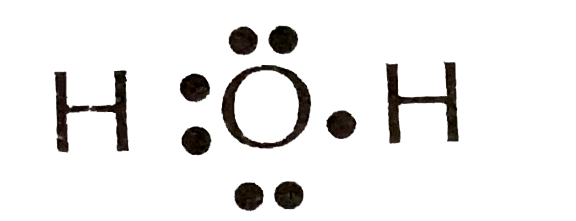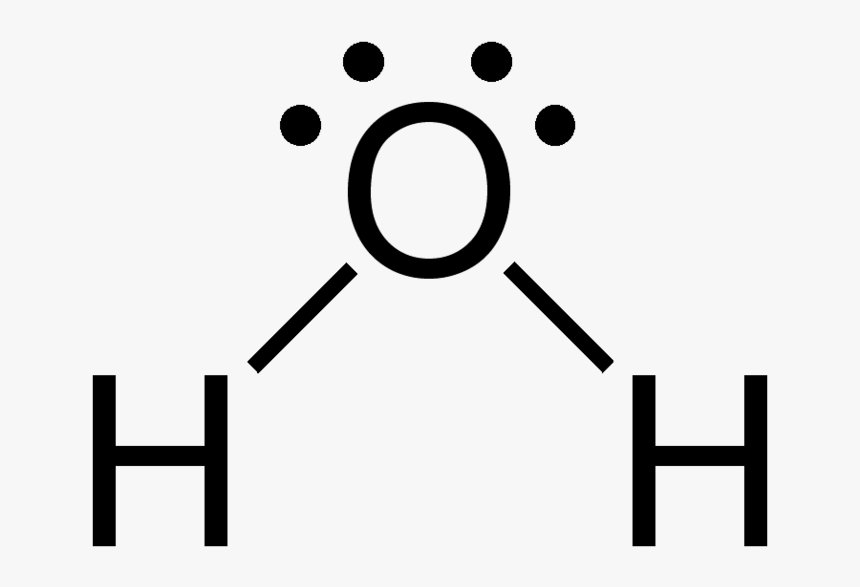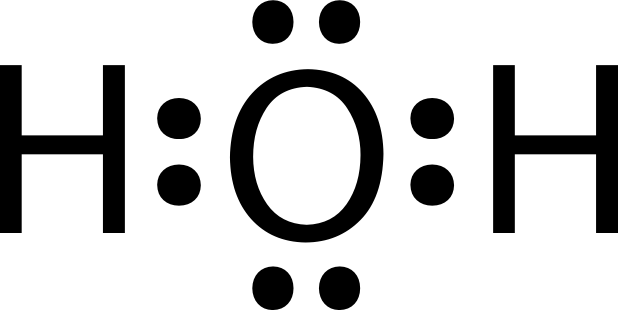
The correct electron dot structure of water molecule is :
(A)

(B)

(C)

(D)

Answer
430k+ views
Hint: The atomic number of oxygen is 8. So, we can say that there are 6 valence electrons. And the atomic number of hydrogen is 1. So, the number of valence electrons is 1.
Complete step by step answer:
The electronic configuration of oxygen is 2, 6. So there are 6 valence electrons available for oxygen in order to form a chemical bonding. Similarly, the electronic configuration of hydrogen is 1. So, there is 1 valence electron available for hydrogen in order to form a chemical bonding.

In the diagram, provided above we get an idea about the structure of water molecules.
Oxygen atom has 6 valence electrons out of which 2 valence electrons are involved in bonding with the 2 hydrogen atoms. Therefore, a water molecule has 2 bond pairs of electrons and 2 lone pair (non-bonded) pairs of electrons.
So, we can say that the Lewis dot structure of of water molecule is:

Therefore, corresponding to the question, we can that the correct Lewis dot structure of water molecules is number 3.
So, Option C is the correct answer.
Note:
(1) Lewis structures also known as Lewis dot structures or electron dot structures are diagrams that represent the valence electrons of an atom within a molecule. These Lewis symbols are Lewis structures which help visualize the valence electrons of atoms and molecules, whether they exist as lone pairs or within bonds.
(2) In order to draw the Lewis dot structure, place any remaining lone electron pairs on the central atom. Usually, electronegative atoms will have lone pairs on them. The number of electrons placed on the molecule should correspond to the total number of valence electrons of the atoms in the molecule.
Complete step by step answer:
The electronic configuration of oxygen is 2, 6. So there are 6 valence electrons available for oxygen in order to form a chemical bonding. Similarly, the electronic configuration of hydrogen is 1. So, there is 1 valence electron available for hydrogen in order to form a chemical bonding.

In the diagram, provided above we get an idea about the structure of water molecules.
Oxygen atom has 6 valence electrons out of which 2 valence electrons are involved in bonding with the 2 hydrogen atoms. Therefore, a water molecule has 2 bond pairs of electrons and 2 lone pair (non-bonded) pairs of electrons.
So, we can say that the Lewis dot structure of of water molecule is:

Therefore, corresponding to the question, we can that the correct Lewis dot structure of water molecules is number 3.
So, Option C is the correct answer.
Note:
(1) Lewis structures also known as Lewis dot structures or electron dot structures are diagrams that represent the valence electrons of an atom within a molecule. These Lewis symbols are Lewis structures which help visualize the valence electrons of atoms and molecules, whether they exist as lone pairs or within bonds.
(2) In order to draw the Lewis dot structure, place any remaining lone electron pairs on the central atom. Usually, electronegative atoms will have lone pairs on them. The number of electrons placed on the molecule should correspond to the total number of valence electrons of the atoms in the molecule.
Recently Updated Pages
Sign up for JEE Main 2025 Live Classes - Vedantu

JEE Main Books 2023-24: Best JEE Main Books for Physics, Chemistry and Maths

JEE Main 2023 April 13 Shift 1 Question Paper with Answer Key

JEE Main 2023 April 11 Shift 2 Question Paper with Answer Key

JEE Main 2023 April 10 Shift 2 Question Paper with Answer Key

JEE Main 2023 (April 6th Shift 2) Chemistry Question Paper with Answer Key

Trending doubts
JEE Main 2025 Session 2: Application Form (Out), Exam Dates (Released), Eligibility & More

JEE Main 2025: Conversion of Galvanometer Into Ammeter And Voltmeter in Physics

JEE Main 2025: Derivation of Equation of Trajectory in Physics

Electric Field Due to Uniformly Charged Ring for JEE Main 2025 - Formula and Derivation

Current Loop as Magnetic Dipole and Its Derivation for JEE

Inertial and Non-Inertial Frame of Reference - JEE Important Topic

Other Pages
NCERT Solutions for Class 11 Chemistry Chapter 9 Hydrocarbons

JEE Advanced Marks vs Ranks 2025: Understanding Category-wise Qualifying Marks and Previous Year Cut-offs

NCERT Solutions for Class 11 Chemistry Chapter 5 Thermodynamics

Hydrocarbons Class 11 Notes: CBSE Chemistry Chapter 9

NCERT Solutions for Class 11 Chemistry Chapter 7 Redox Reaction

Thermodynamics Class 11 Notes: CBSE Chapter 5




